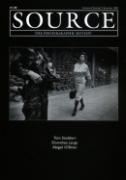Irish Photography in Paris
'Imaginaire Irlandais' and 'Printemps Celte' took place in Paris, 1996
Review by Christian Caujolle
Issue 8 Summer 1996
View Contents ▸
In France, 1996 is the year of the Irish. From 'Irish Imagination' (Imaginaire Irlandais) to 'Celtic Spring' (Printemps Celte), from anthologies of Irish poetry to celebrations of Joyce and Beckett, from music to storytelling, and from dance to lectures on whiskey, it's impossible for even a moderately well-informed French person to avoid Ireland. John Duncan
John Duncan
Of all the photographers exhibited or published, Mike O'Kelly has been the most noteworthy, particularly thanks to the spectacular exhibition of his work in La Grande Halle de la Villette where eight of his portraits (two of which were produced specially for the Paris show), which were presented in huge format presented in space, served as an introduction to 'Celtic Spring' which attracted nearly 40,000 people. Work from the same series was also on show at the exhibition at La Chapelle de L'Ecole des Beaux Arts (Chapel of the School of Fine Art). In addition , his work was shown at the National Centre of Photography in the 'Lie of the Land' exhibition. But the ability to read those of his portraits which contain written words was not helped by the close proximity of a chimney...
It must be said however that this exhibition , which brought together the works of the above-mentioned artist along with those by John Duncan, Padraig Murphy, Anthony Haughey, Victor Sloan and Paul Seawright, was rather restricted due to the unaccommodating space and scattered throughout small rooms on the first floor of the Hotel Salomon de Rothschild. The selection of artists (shown for the first time in Paris) was coherent, representative of the diversity of contemporary approaches and could only be criticised for the absence of an element of photojournalism in its classic form.
From the conceptual to 'reportage' using cleverly treated colours, it is the whole questioning of one's attitude towards reality which is highlighted, thus proving (if indeed, proof be needed) that photography in Ireland addresses the very same questions which motivate this art form across the world. Quite simply, the special circumstances in this country lead (in whichever form is adopted) to a very special radicalism, a form of tension, of political conscience which permeates all the works and underlines their individuality.
The predominance of works in colour, with a range of different approaches by each artist, reminds us that 'colourism' is one of today's central questions and that, from the exaggeration of colour to the quest for the monochrome or the hyper-banal, the aesthetic positions adopted carry meaning.
When it's a case of group exhibitions, where too few of each artist's work are represented, (also because of the sheer size of artist's prints, which are often aimed at contemporary art, museums and sales) it is always unfair to state preferences. It isn't, for example, on seeing the exhibits at the National Centre of Photography that one could grasp the importance of Mike O'Kelly's work... But it would also be unfair to mention the success and the excellence of certain pieces. First of all, we have the colour-squares of Anthony Haughey, whose control of framing, daring, and mastery of shade-based composition, really makes one yearn for a personal exhibition. The same desire can be applied to Paul Seawright, of one could only criticise his occasional yielding to the power of violent framing with flash-effects which are more spectacular than intensely thought provoking. If only he didn't use special effects so excessively, his work would be of the highest calibre.
Beyond the pure pleasure of discovery, the exhibition created by Christine Redmond will have achieved, despite the cramped presentation, the opportunity of introducing Irish artists who are undoubtedly part of the panorama of contemporary European photography at its best.
Other articles mentioning John Duncan:
Other articles mentioning Anthony Haughey:
Other articles mentioning Victor Sloan:
Other articles mentioning Paul Seawright:
Other articles on photography from the 'Multi-Genre' category ▸






